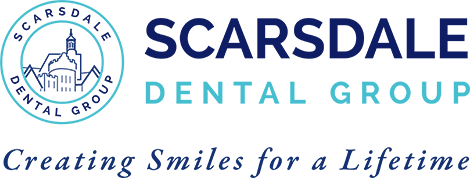What is TMJ? The acronym stands for temporomandibular joint or jawbone. The term refers to a disorder of the joint where the lower jaw attaches to the skull at the temple. The disorder can restrict movement, impact chewing ability, result in bite misalignment, and cause damage to teeth.
How do you know if you are suffering from TMJ? There are 3 common symptoms you should not ignore. If you notice any of the following symptoms, call Scarsdale Dental Group at (914) 723-4707 to make an appointment for an exam and possible treatment for TMJ.
Pain in the Jaw
Have you been experiencing pain in your jaw? The most common time to notice this pain is first thing in the morning (possibly from grinding your teeth while you sleep). You may also notice jaw pain when you are chewing, talking, or especially yawning.
Frequent Headaches
Do you experience frequent headaches that appear to have no obvious cause? If so, and especially if the pain tends to originate in your temples or forehead it could be an indication of a TMJ problem. Sometimes these headaches will be felt in the neck as a result of TMJ. People under stress will report increased jaw muscle and tension headaches late in the day. This is often related to daytime clenching and poor posture while sitting at a computer.
Problems Chewing
If you have any difficulty chewing, whether it’s tough foods like meat or even soft foods, it may be the result of TMJ associated with a bite. You may also find that your bite seems awkward; this is most noticeable while eating.
Don’t Ignore These Symptoms
If you’re regularly experiencing any of the above symptoms, don’t ignore it. You need to see a dentist for a thorough exam and possible treatment for TMJ. Ignoring the symptoms for too long can make the disorder worse and more difficult to correct. It can also cause long term damage to your teeth from improper bite alignment.
What is Happening in the Joint when you have TMJ?
The temporomandibular joint is the place where the lower jaw bone attaches to the head. The bones at the joint are covered with cartilage and there is a disk in between the jaw bone and the skull where it attaches. The disk is there to absorb shock and keep jaw movement smooth. In cases of TMJ, there are a few possible problems occurring at this joint:
- The disk has slipped out of place.
- The disk has eroded.
- The cartilage is damaged by arthritis.
- The joint is damaged by an injury.
Sometimes there is not a clear or obvious cause of TMJ. You can simply be aware of the symptoms and visit your dentist for a diagnosis.
Who is at a Higher Risk of TMJ?
While TMJ can happen to anyone, there are some risk factors that can increase the likelihood that you may develop a jaw disorder, such as:
- You grind your teeth.
- You suffer from arthritis, including osteoarthritis and rheumatoid arthritis.
- You have a disease that affects connective tissues.
- You have experienced a jaw injury.
These situations put people at a higher risk for developing TMJ, but will not necessarily cause it.
Treatment Options for TMJ
There are a few different approaches to treating TMJ, both with and without medication.
Dental Appliance
A dental appliance can be worn to relax the muscles and realign the bite. It also helps to prevent grinding teeth which can exacerbate the problem.
Medication
Muscle relaxers and other medications can be used to treat TMJ. These are often used in conjunction with a dental appliance.
Surgery
In some severe cases it may be in the patient’s best interest to be referred to a surgeon for further treatment.
Any combination of these treatment options may be used to correct your TMJ and relieve the pain and other symptoms associated with it.
Effective Treatment for TMJ at Scarsdale Dental Group
If you’re experiencing symptoms of TMJ, don’t ignore them. Call (914) 723-4707 today to make an appointment with Scarsdale Dental Group. The sooner you receive treatment, the better for the health of your jaw and teeth.

